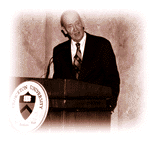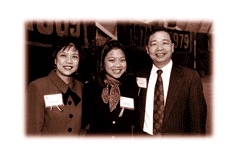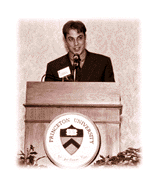Alumni Day - March 24, 1999
Gomory and Bogle honored
Technologist, investor discuss electronic education and mutual funds
 Some 1,300 Princetonians gathered on campus on February 20 for the 84th
Alumni Day. They attended receptions, workshops, and lectures on a variety
of topics, including community-based learning, computing with DNA, lying,
attention and consciousness, and privacy in an age of expanding information
technology. Princetonians also commemorated deceased alumni at the Service
of Remembrance in the University Chapel, where Stephen E. Hollaway '74 delivered
the memorial address.
Some 1,300 Princetonians gathered on campus on February 20 for the 84th
Alumni Day. They attended receptions, workshops, and lectures on a variety
of topics, including community-based learning, computing with DNA, lying,
attention and consciousness, and privacy in an age of expanding information
technology. Princetonians also commemorated deceased alumni at the Service
of Remembrance in the University Chapel, where Stephen E. Hollaway '74 delivered
the memorial address.
The day's chief honorees, Ralph E. Gomory *54, who was awarded the James
Madison Medal as a distinguished alumnus of the Graduate School, and John
C. Bogle '51, the winner of the Woodrow Wilson Award for undergraduate alumni
exemplifying Princeton in the nation's service, gave lectures in Alexander
Hall.
Gomory, president of the Alfred P. Sloan Foundation, which awards grants
for programs in science and technology, discussed education over the Internet
and what it means for higher education. A Higgins Lecturer in Mathematics
at Princeton before joining IBM in 1959, Gomory became president of the
Sloan Foundation in 1989, when he retired from IBM.
Through the Internet, said Gomory, "education and training, like
light, will be easily available to anyone, anytime, anywhere." New
technologies that have made online courses possible are changing the nature
of the classroom. Virtual classrooms, he said, "enable learning to
leap over the limitations that have always bound the professor and class
to be in the same place at the same time."
Courses and degree programs offered over the Internet, said Gomory, make
higher education and advanced training available to people who otherwise
might not be able to pursue higher education -- those who work, who are
raising families, and who don't live close to a college or university. People
can learn at any stage of life if they don't need to be on a campus, he
said.
The Sloan Foundation is advancing this new wave of education by funding
Asynchronist Learning Networks (ALNs) at institutions across the country.
By the end of this academic year, Gomory estimated, 40,000 students will
be taking courses and 35 degree programs will be offered through institutions
receiving grants from the Sloan Foundation.
Learning outcomes for those taking courses over the Internet are comparable
to their in-class counterparts, he said. "Students are actually learning."
Nonetheless, designers of ALNs still have important questions to address,
including how people learn in this virtual environment; how professors and
students should interact; what the right class size is; and whether students
need to get together occasionally in an actual classroom.
Two drawbacks to learning through ALNs, said Gomory, are that students
do not get immediate feedback from their professors, and that laboratories
cannot be completely reproduced online. (A student can't dissect a mouse
online, for example.) Among the advantages of ALNs is the ability to have
homework corrected instantly.
ALNs, said Gomory, will increase the market for higher education and
advanced training. The institutions able to reach out to this growing market
are subsidized schools that survive mainly on tuition or whose state support
grows proportionately with enrollment, he said. Elite institutions, however,
will not find it feasible to add more students, since tuition covers only
a fraction of what it costs to educate a student. Nevertheless, Gomory hopes
that elite private institutions will find ways to reach out to this new
market and will not leave electronic education only to for-profit or government-sponsored
schools.
Hedgehogs and foxes
Bogle, who has been involved in finance since 1951 and founded the mutual-fund
firm the Vanguard Group in 1974, spoke about Vanguard's unusual mission
and investment strategy in "Changing the Rules of Investing: The Hedgehog
and the Fox."
Bogle said his career started by accident during his senior year, when
he was searching for a topic for his thesis in economics. While studying
in Firestone Library in December 1949, he read an article in Fortune
about the then-emerging mutual-fund industry. He went on to write a thesis
that predicted what future directions the industry might take.
Fifty years later, Bogle has been responsible for many changes in his
business. His mission from the beginning, he said, has been to ensure that
investors get a "fair shake." He characterized the Vanguard Group,
one of the two largest mutual-fund organizations in the world, as a "hedgehog,"
that is, a financial institution that knows one great thing -- "long-term
investment success is based on simplicity." Many of the other mutual-fund
institutions, he said, are "foxes," surviving by knowing many
things about complex markets.
Hedgehogs invest for the long term. They buy shares of businesses and
hold them, ignoring the mercurial nature of the stock market. "This
hedgehog strategy is the rock upon which Vanguard's investment strategy
rests," said Bogle.
According to Bogle, Vanguard's strategy is defined by "holding the
interests of the shareholders paramount," treating investors as "human
beings," increasing investors' returns by vastly reducing management
fees, and focusing on prudent management instead of aggressive marketing.
"We are, in a word, cheap," he said.
By contrast, said Bogle, the foxes of the mutual-fund industry make investing
complicated. They employ professional money managers that hover over their
portfolios by the hour, constantly monitoring and changing holdings, which
drives up management costs. In the end, fund shareholders earn returns 15
to 20 percent below the returns of the stock market itself. According to
Bogle, the financial success of fund managers depends not on earning a market
return on their investors' capital but on earning a "staggering return
on their own capital." There's so much money to be made in managing
money if you charge high fees, he said, that other mutual-fund managers
don't want to follow Vanguard's lead.
Upon receiving the Woodrow Wilson Award later that day in Jadwin Gymnasium,
Bogle, who underwent a heart transplant three years ago, held back tears
as he thanked his mentor, the late Walter L. Morgan '20. It was Morgan,
said Bogle, who gave him his first job at his own Wellington Fund after
reading Bogle's senior thesis: "I can't imagine my life without him."
-- Kathryn Federici Greenwood
Alumni Day awards ceremony
Alumni, students, and friends gathered in Jadwin Gymnasium for the annual
Alumni Day luncheon and awards ceremony. Richard O. Scribner '58, the chairman
of the national Annual Giving committee, reported on the progress of this
year's AG effort and the five-year Anniversary Campaign. To date, AG has
raised $15.6 million from 29 percent of alumni toward its June 30 goal of
$33 million from 63 percent. "In participation, we're behind where
we need to be to reach our goal," he said. With a year and a half to
go, the Anniversary Campaign has raised $714 million toward its new goal
of $900 million in capital gifts and AG funds by June 30, 2000. "We
have many dollars yet to raise," said Scribner.
Brent L. Henry '69, the chairman of the Alumni Council, President Shapiro,
and Scribner presented the following awards to alumni and students:
 The M. Taylor Pyne Prize, the university's
highest general award for undergraduates, was shared by seniors Renee Hsia
and Alexander Sierk. The two will split an amount equal to this year's tuition
($23,820). They were selected as the seniors who most clearly manifested
"excellence in scholarship, character, and effective support of the
best interests of Princeton."
The M. Taylor Pyne Prize, the university's
highest general award for undergraduates, was shared by seniors Renee Hsia
and Alexander Sierk. The two will split an amount equal to this year's tuition
($23,820). They were selected as the seniors who most clearly manifested
"excellence in scholarship, character, and effective support of the
best interests of Princeton."
A public-policy major at the Woodrow Wilson School, Hsia plans to attend
medical school and earn a master's in public health before embarking on
a career in public health in developing countries. Hsia, who speaks Mandarin
and Cantonese, is writing her senior thesis on the activities of nongovernmental
organizations in China, which she visited in the summer of 1998. She is
also pursuing a certificate in East Asian studies and in Chinese language,
and she has a straight-A average.
As a junior, Hsia studied in the South African township of Guguletu as
part of a Wilson School policy task force on education, focusing on children
with special needs.
Hsia has been involved with the Princeton Evangelical Fellowship, the
Symphony Orchestra, the Woodrow Wilson School Advisory Council, and the
Student Volunteers Council, having served as project director for the Conversational
English Program. The program pairs Princeton students with spouses of graduate
students or visiting scholars from foreign countries who wish to improve
their English skills.
Hsia has won several awards and scholarships during her tenure at Princeton,
including the Paul and Daisy Soros Fellowship for New Americans, which will
fund half the tuition costs for two years of graduate study at the school
of her choice and give her a $20,000 stipend for living expenses each year.
In accepting the Pyne Prize, Hsia, who called herself a "Chinese-American
girl from Texas," said, "Princeton has exposed me to the world
and made the world my classroom."
 A molecular biology major from Bettendorf, Iowa, Sierk was also a record-setting
place-kicker on the football team for four years. Like Hsia, he plans to
attend medical school after graduation. Sierk's senior thesis is on the
p53 gene, the most important known tumor suppressor. His research has focused
on analyzing samples of human colon cancer.
A molecular biology major from Bettendorf, Iowa, Sierk was also a record-setting
place-kicker on the football team for four years. Like Hsia, he plans to
attend medical school after graduation. Sierk's senior thesis is on the
p53 gene, the most important known tumor suppressor. His research has focused
on analyzing samples of human colon cancer.
Sierk scored the first six points in the new Princeton University Stadium.
His freshman year he kicked a field goal in the final play in that season,
winning for Princeton its first outright Ivy League championship in 31 years.
Sierk received All-Ivy honors in 1997 and 1998 and received a graduate fellowship
from the National Football Foundation and the College Hall of Fame, along
with other awards.
In addition to his work in the classroom, in the lab, and on the field,
Sierk volunteered as a Big Brother and participated in a mentoring program
at the Newgrange School, in Trenton, which serves learning-disabled students.
In accepting the award, Sierk thanked his parents, who "came to
all 10 football games this fall -- from Iowa."
The Porter Ogden Jacobus Fellowship was
awarded to Stanislav Boldyrev, a graduate student in the Department of Astrophysical
Sciences' Program in Plasma Physics. The university gives the prize to the
graduate student "who displays the highest scholarly excellence,"
in the judgment of the faculty. The fellowship funds the final year of graduate
study.
Born in Moscow, Boldyrev is a theoretical physicist working on the theory
of intermittent fluid turbulence. In particular, his research concentrates
on the application of methods of quantum field theory to describe fundamental
properties of stochastical fluid motion. In an unusual achievement, he passed
his general exams after only one year at Princeton.
The S. Barksdale Penick, Jr. '25 Award went
to the alumni schools committee of the Princeton Alumni Association of Eastern
Fairfield County, Connecticut, chaired by Henry Von Kohorn '66. The prize
recognizes the regional group that has "most effectively realized the
primary goals of Alumni Schools Committee work" in recruiting students
and representing Princeton to its local community.
The Alumni Council Award for Community Service
honored the Class of 1939 for the Fred Fox '39 Fund, which offers financial
assistance to undergraduates for special projects or work experience related
to their course of study or otherwise contributing to their personal development
through social services. The fund awards as many as 40 grants of up to $400
annually. As a 250th Anniversary project, the Class of 1939 undertook to
raise a $250,000 endowment to perpetuate the fund. Contributions toward
the endowment to date exceed that goal. This year the Class of 1939 will
turn over the operation of the fund to the university, with the class's
support being replaced by endowment income. The Alumni Council established
the community service award six years ago to "recognize outstanding
contributions by groups of Princetonians in their efforts to address critical
social, economic, and environmental needs."
The Harold H. Helm '20 Award for "exemplary
and sustained service" to AG was given to Elise P. Wright '83. She
has served as regional chairwoman for Eastern Connecticut and recently completed
a five-year term as class agent. Under her leadership, the Class of 1983
last year set a 15th-reunion record by raising $872,000 from 70.5 percent
of the class.
The Class of 1926 Trophy, which goes to
the class that raises the largest amount for AG, was awarded to the Class
of 1963, led by Class Agent Malcolm MacKay. The class set a 35th-reunion
record with a total of $4,000,036. This is the third time that the Class
of 1963 has won this award. It is also the all-time leading class for AG
contribution, with a lifetime total of $13.3 million.
The Jerry Horton '42 Award for an outstanding
regional committee that has "expanded the knowledge and awareness of
Annual Giving" was presented to the AG committee of Canada, chaired
by J. Paul Mills '64. Last year its participation reached 56 percent.
GO TO
the Table of Contents of the current issue
GO TO PAW's
home page
paw@princeton.edu
 Some 1,300 Princetonians gathered on campus on February 20 for the 84th
Alumni Day. They attended receptions, workshops, and lectures on a variety
of topics, including community-based learning, computing with DNA, lying,
attention and consciousness, and privacy in an age of expanding information
technology. Princetonians also commemorated deceased alumni at the Service
of Remembrance in the University Chapel, where Stephen E. Hollaway '74 delivered
the memorial address.
Some 1,300 Princetonians gathered on campus on February 20 for the 84th
Alumni Day. They attended receptions, workshops, and lectures on a variety
of topics, including community-based learning, computing with DNA, lying,
attention and consciousness, and privacy in an age of expanding information
technology. Princetonians also commemorated deceased alumni at the Service
of Remembrance in the University Chapel, where Stephen E. Hollaway '74 delivered
the memorial address. The M. Taylor Pyne Prize, the university's
highest general award for undergraduates, was shared by seniors Renee Hsia
and Alexander Sierk. The two will split an amount equal to this year's tuition
($23,820). They were selected as the seniors who most clearly manifested
"excellence in scholarship, character, and effective support of the
best interests of Princeton."
The M. Taylor Pyne Prize, the university's
highest general award for undergraduates, was shared by seniors Renee Hsia
and Alexander Sierk. The two will split an amount equal to this year's tuition
($23,820). They were selected as the seniors who most clearly manifested
"excellence in scholarship, character, and effective support of the
best interests of Princeton." A molecular biology major from Bettendorf, Iowa, Sierk was also a record-setting
place-kicker on the football team for four years. Like Hsia, he plans to
attend medical school after graduation. Sierk's senior thesis is on the
p53 gene, the most important known tumor suppressor. His research has focused
on analyzing samples of human colon cancer.
A molecular biology major from Bettendorf, Iowa, Sierk was also a record-setting
place-kicker on the football team for four years. Like Hsia, he plans to
attend medical school after graduation. Sierk's senior thesis is on the
p53 gene, the most important known tumor suppressor. His research has focused
on analyzing samples of human colon cancer.